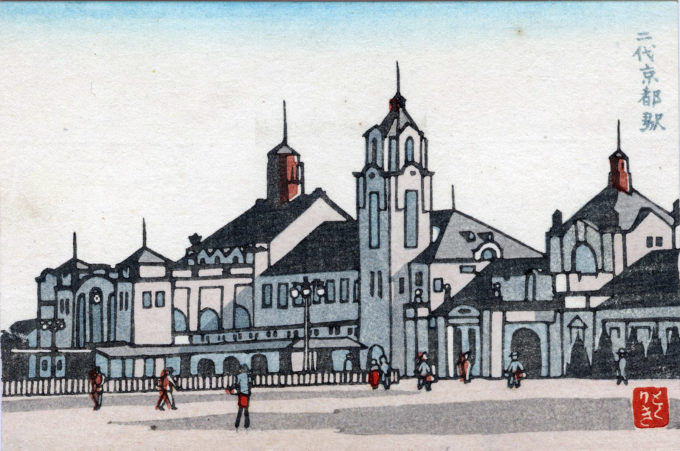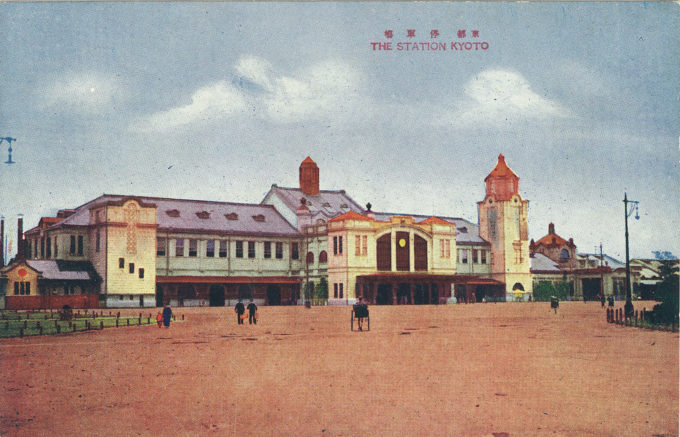
Second Kyoto Railroad Terminal, c. 1950, a shin-hanga reproduction attributed to Tokuriki Tomikichiro. The reverse of this postcard is captioned “Kyoto Station, completion of construction [in 1914].” This terminal burned to ground in 1950, and was replaced by an unattractive two-story ferro-concrete building typical of the blockish, gray architecture of post-war Japanese construction.
See also:
Tokyo Station, 1914-1940.
Kobe Station, c. 1920.
Manseibashi Station, Tokyo (1912-1936).
The Station (1914-1950)
“The story of Kyoto Station is a story of Kyoto’s progress through the modern era. Three Kyoto Stations were built before the current building, each showing a gradual increase in size and utility. The first, built in 1877, was built in red brick, the most modern material of the time, and seemed to usher in a new era of technological progress. Much excitement attended its opening ceremony, which was attended by the Emperor Meiji himself.
“The second Kyoto Station [seen in the postcard image] was built in 1914 to coincide with the enthronement ceremony of the new Emperor Taisho in Kyoto Imperial Palace. This building was an elegant and spacious Renaissance style structure and considered an object of pride by the national railway.
“Built largely of cypress wood it stood pretty much in the area of the current building, the site of the first station becoming an expansive public square. Unfortunately, on November 18th 1950 someone forgot to turn off an electric iron in one of the station’s changing rooms. This mistake caused a fire that quickly spread and, as cypress wood burns easily, the station was completely destroyed.
“The third Kyoto Station was built in a hurry to replace the one that had been lost – a blockish, two-storey structure with an eight-storey tower, constructed of the popular material of the day: concrete.
“This third station was large and practical … but ugly. As Kyoto increasingly modernized, with bullet train connections and a subway, calls began in the 1970s for a new more visually appealing building.”
– Kyoto Station web site
The Artist
“Tomikichiro Tokuriki was born March 22, 1902, in Kyoto, Japan. The first teacher of the young Tomikichiro was his grandfather. Later he entered the Kyoto School of Arts and Crafts with a two-year preparatory class and four years of regular training, and later a three year training at the Kyoto College of Art. He graduated from Kyoto Art College in 1923.
“I’d rather do nothing but creative prints [sosaku hanga], but after all, I sell maybe ten of them against two hundred for a publisher-artisan print [shin hanga].”
– Tokuriki Tomikichiro“Tokuriki produced two lines of prints. There were the sosaku hanga prints, meaning creative prints, which were his real passion. And then there was his bread and butter art: pastel-like prints in soft colors with scenes of Japanese landscape and famous places. It is hard to believe! These are the prints for which he is popular. And these Tomikichiro prints in shin hanga style are neither kitschy nor poorly made, but wonderful, solid designs in traditional Japanese style.
“While the artist published his creative hanga-style prints himself, Tokuriki’s artisan-prints were published by Uchida, Unsodo and other Kyoto publishers.”
– Artelino



Pingback: Kobe Station, Kobe, c. 1910. | Old TokyoOld Tokyo